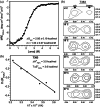Protein yoga: Conformational versatility of the Hemolysin II C-terminal domain detailed by NMR structures for multiple states
- PMID: 33733504
- PMCID: PMC8040871
- DOI: 10.1002/pro.4066
Protein yoga: Conformational versatility of the Hemolysin II C-terminal domain detailed by NMR structures for multiple states
Abstract
The C-terminal domain of Bacillus cereus hemolysin II (HlyIIC), stabilizes the trans-membrane-pore formed by the HlyII toxin and may aid in target cell recognition. Initial efforts to determine the NMR structure of HlyIIC were hampered by cis/trans isomerization about the single proline at position 405 that leads to doubling of NMR resonances. We used the mutant P405M-HlyIIC that eliminates the cis proline to determine the NMR structure of the domain, which revealed a novel fold. Here, we extend earlier studies to the NMR structure determination of the cis and trans states of WT-HlyIIC that exist simultaneously in solution. The primary structural differences between the cis and trans states are in the loop that contains P405, and structurally adjacent loops. Thermodynamic linkage analysis shows that at 25 C the cis proline, which already has a large fraction of 20% in the unfolded protein, increases to 50% in the folded state due to coupling with the global stability of the domain. The P405M or P405A substitutions eliminate heterogeneity due to proline isomerization but lead to the formation of a new dimeric species. The NMR structure of the dimer shows that it is formed through domain-swapping of strand β5, the last segment of secondary structure following P405. The presence of P405 in WT-HlyIIC strongly disfavors the dimer compared to the P405M-HlyIIC or P405A-HlyIIC mutants. The WT proline may thus act as a "gatekeeper," warding off aggregative misfolding.
Keywords: conformational transitions; protein aggregation; protein dynamics; protein evolution; protein substates; structure plasticity; β-pore-forming toxin.
© 2021 The Protein Society.
Conflict of interest statement
The authors declare no potential conflict of interest.
Figures





Similar articles
-
NMR structure of the Bacillus cereus hemolysin II C-terminal domain reveals a novel fold.Sci Rep. 2017 Jun 12;7(1):3277. doi: 10.1038/s41598-017-02917-4. Sci Rep. 2017. PMID: 28607368 Free PMC article.
-
NMR assignments for the cis and trans forms of the hemolysin II C-terminal domain.Biomol NMR Assign. 2014 Oct;8(2):419-23. doi: 10.1007/s12104-013-9530-2. Biomol NMR Assign. 2014. PMID: 24234348
-
A Monoclonal Antibody against the C-Terminal Domain of Bacillus cereus Hemolysin II Inhibits HlyII Cytolytic Activity.Toxins (Basel). 2020 Dec 19;12(12):806. doi: 10.3390/toxins12120806. Toxins (Basel). 2020. PMID: 33352744 Free PMC article.
-
Utilizing Extraepitopic Amino Acid Substitutions to Define Changes in the Accessibility of Conformational Epitopes of the Bacillus cereus HlyII C-Terminal Domain.Int J Mol Sci. 2023 Nov 17;24(22):16437. doi: 10.3390/ijms242216437. Int J Mol Sci. 2023. PMID: 38003626 Free PMC article.
-
Emerging issues of connexin channels: biophysics fills the gap.Q Rev Biophys. 2001 Aug;34(3):325-472. doi: 10.1017/s0033583501003705. Q Rev Biophys. 2001. PMID: 11838236 Review.
Cited by
-
Pulse-field gradient nuclear magnetic resonance of protein translational diffusion from native to non-native states.Protein Sci. 2022 May;31(5):e4321. doi: 10.1002/pro.4321. Protein Sci. 2022. PMID: 35481638 Free PMC article.
-
The Temperature Dependence of Hydrogen Bonds Is More Uniform in Stable Proteins: An Analysis of NMR h3JNC' Couplings in Four Different Protein Structures.Molecules. 2024 Jun 21;29(13):2950. doi: 10.3390/molecules29132950. Molecules. 2024. PMID: 38998901 Free PMC article.
-
Templated trimerization of the phage L decoration protein on capsids.bioRxiv [Preprint]. 2024 Sep 8:2024.09.08.611893. doi: 10.1101/2024.09.08.611893. bioRxiv. 2024. Update in: Protein Sci. 2025 Apr;34(4):e70089. doi: 10.1002/pro.70089. PMID: 39282432 Free PMC article. Updated. Preprint.
-
Templated trimerization of the phage L decoration protein on capsids.Protein Sci. 2025 Apr;34(4):e70089. doi: 10.1002/pro.70089. Protein Sci. 2025. PMID: 40100157
-
Genetic Perturbation Alters Functional Substates in Alkaline Phosphatase.J Am Chem Soc. 2023 Feb 8;145(5):2806-2814. doi: 10.1021/jacs.2c06693. Epub 2023 Jan 27. J Am Chem Soc. 2023. PMID: 36706363 Free PMC article.
References
-
- Stenfors Arnesen LP, Fagerlund A, Granum PE. From soil to gut: Bacillus cereus and its food poisoning toxins. FEMS Microbiol Rev. 2008;32:579–606. - PubMed
-
- Turnbull PC, Kramer JM, Jorgensen K, Gilbert RJ, Melling J. Properties and production characteristics of vomiting, diarrheal, and necrotizing toxins of Bacillus cereus . Am J Clin Nutr. 1979;32:219–228. - PubMed
-
- Lund T, De Buyser ML, Granum PE. A new cytotoxin from Bacillus cereus that may cause necrotic enteritis. Mol Microbiol. 2000;38:254–261. - PubMed
-
- Andreeva ZI, Nesterenko VF, Yurkov IS, Budarina ZI, Sineva EV, Solonin AS. Purification and cytotoxic properties of Bacillus cereus hemolysin II. Protein Expr Purif. 2006;47:186–193. - PubMed
Publication types
MeSH terms
Substances
LinkOut - more resources
Full Text Sources
Other Literature Sources

